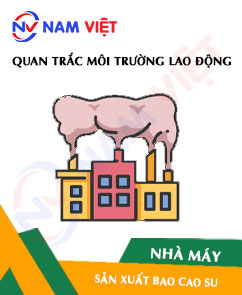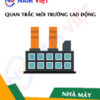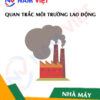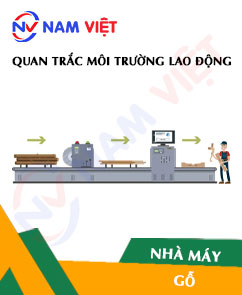Occupational Environment Monitoring at the Condom Manufacturing Factory
99,000 ₫
Note: The above price is calculated for one sample, and the price may fluctuate depending on the area of the environment to be monitored and market movements. For more accurate pricing support, please refer to the pricing table or contact our consulting staff directly.
Environmental monitoring of a condom manufacturing factory is a session of collecting, analyzing, and evaluating workplace factors that may be harmful to workers’ health.
Table of Contents
Toggle1. Overview of Condom Manufacturing Factories
a. What is a Condom Manufacturing Factories?
Manufacturing Factory of condoms is a facility specialized in producing various types of condoms. Condoms are contraceptive products used to prevent pregnancy and sexually transmitted diseases. The condom manufacturing factory is responsible for producing, packaging, and distributing different types of condoms to the consumer market.

b. Production stages in a condom manufacturing factory
The production stages in a condom manufacturing factory include:
- Material preparation: The main material for condom production is natural rubber. Rubber is harvested from rubber trees and then processed into liquid or solid rubber.
- Mixing and processing materials: Rubber materials are mixed with additives such as softeners, anti-sticking agents, and shaping agents. This mixing and processing process aims to create a rubber blend suitable for condom production.
- Shaping and molding: The rubber blend is placed into molds or presses to form the condom shape. This process includes shaping, compressing, and defining the length and thickness of the condom.
- Drying and heat treatment: Condoms are placed in ovens to remove moisture and enhance durability. The drying and heat treatment process makes the condoms flexible and resistant to shrinkage.
- Quality control: Condoms are inspected to ensure they meet safety and quality standards. Quality inspection may include testing thickness, strength, leak resistance, surface quality, and other requirements.
- Packaging: Condoms, after passing quality inspection, are packaged into individual packs such as boxes or pouches. This packaging process ensures preservation and hygiene of the condoms.

c. Machinery used in a condom manufacturing factory
In a condom manufacturing factory, various machinery and equipment are used to perform production stages. Some common machines in condom manufacturing include:
- Rubber mixer: Used to blend rubber materials with additives to create a homogeneous rubber mixture suitable for condom production.
- Condom press: Used to shape and mold condoms. The molds or presses compress the rubber to form the desired size and shape.
- Drying machine: Used to remove moisture from condoms after molding. The drying process ensures the condoms are dry and have necessary durability.
- Quality inspection machine: Used during production to check technical parameters and product quality, including thickness, strength, elasticity, leak resistance, and surface quality.
- Packaging machine: Used to pack condoms after production and quality inspection into boxes or individual pouches, ensuring product preservation and hygiene.
- Printing machine: Used to print labels, logos, or images on condoms to build brand identity and product recognition.

d. Occupational diseases that may occur for workers in a condom manufacturing factory
Workers in condom manufacturing factories may be exposed to harmful and hazardous environmental factors, leading to the risk of occupational diseases. Some common occupational diseases in the condom industry include:
- Skin allergies: Exposure to chemicals during production may cause skin allergies, itching, dermatitis, and other skin irritations.
- Respiratory problems: Exposure to chemical compounds, dust, and toxic fumes may cause respiratory issues such as rhinitis, sinusitis, bronchitis, and pneumonia in polluted work environments.
- Hearing problems: Noise from machinery and equipment in the factory can cause hearing issues, such as hearing loss and tinnitus.
- Musculoskeletal disorders: Repetitive motions in condom production can strain muscles and bones, causing neck pain, back pain, and joint degeneration.
- Neurological issues: Some chemicals in the production process may affect the nervous system, causing headaches, dizziness, insomnia, and seizures.
To prevent occupational diseases, safety and health protection measures should be applied in condom manufacturing factories. This includes using personal protective equipment, labor safety training, controlling toxic substances and noise, maintaining workplace hygiene, and providing healthcare programs for workers.

e. Popular types of condoms on the market
There are many popular types of condoms on the market, including:
- Regular condoms: Standard condoms made from natural rubber or synthetic latex. They have standard size and thickness, suitable for most users.
- Ultra-thin condoms: Thinner than regular condoms, designed to increase intimacy and natural sensation.
- Textured condoms: Condoms with ribs, studs, or bumps to enhance stimulation and sexual pleasure.
- Flavored condoms: Condoms with added flavors such as fruit, massage, or herbal scents to stimulate senses and increase enjoyment.
- Lubricated condoms: Pre-lubricated condoms to reduce friction and increase smoothness during intercourse.
- Special size condoms: Condoms designed for specific sizes, such as smaller or longer condoms.
- Delay condoms: Condoms containing delay agents to prolong sexual activity.
- Novelty condoms: Includes neon condoms, glow-in-the-dark condoms, or printed/illustrated condoms for added variety and fun.
2. Overview of Occupational Environment Monitoring Services
a. What is occupational environment monitoring at a condom manufacturing factory?
Occupational environment monitoring (or workplace environmental measurement) at a condom manufacturing factory is the activity of collecting, evaluating, and analyzing measured indicators of workplace environmental factors at the factory. The goal is to implement timely measures to reduce environmental harm to workers’ health and prevent occupational diseases. Occupational environment monitoring is mandatory for condom manufacturing factories.
Occupational environment monitoring plays a crucial role in caring for, protecting, and improving worker health, as workers are the main resource of the enterprise and directly generate profit. Workers frequently exposed to hazardous and occupational risk factors beyond allowable limits are at risk of health impacts and occupational diseases.
REGISTER FOR OCCUPATIONAL ENVIRONMENT MONITORING SERVICE
b. Nam Viet’s occupational environment monitoring program
Nam Viet’s occupational environment monitoring program is developed by engineers specializing in occupational safety and environmental protection. Aiming to ensure workers’ health and safety, the program uses modern measurement methods to monitor air quality, water, microclimate, physical factors, dust, and other environmental factors in the workplace. This program is essential for ensuring a safe working environment and protecting workers’ health.
Additionally, Nam Viet’s program plays a key role in researching and developing new solutions to improve workplace environmental quality. With the dedication and professionalism of its expert team, Nam Viet’s exclusive monitoring program has become a breakthrough in occupational safety and environmental protection management in Vietnam.

c. Standardization in workplace environmental measurement procedures
Standardization in Nam Viet’s workplace measurement procedures is crucial for ensuring the quality of results. To guarantee accuracy and reliability, the program uses recognized standards and procedures from Ho Chi Minh City Department of Health. This ensures that collected data is reliable for evaluating workplace conditions and making decisions to improve the environment and protect workers’ health.
These standardized procedures also ensure that measurement results are performed by highly qualified monitoring specialists with years of experience, allowing managers and experts to rely on An Toàn Nam Việt’s results for accurate, valuable decisions in protecting workers’ health and the environment.
By applying standardization in environmental measurement procedures, Nam Viet demonstrates its commitment to ensuring a safe working environment and protecting worker health, while contributing to improving occupational safety and environmental management quality in Vietnam.
d. Occupational environment monitoring report for condom manufacturing factory
The monitoring results are compiled according to Form 04, Appendix III issued with Decree 44/2016/ND-CP and prepared in 2 copies: 1 copy is sent to the contracting workplace, and 1 copy is kept by the monitoring organization.
The storage duration for occupational environment monitoring results is indefinite as regulated by law.

e. Frequency of occupational environment monitoring according to the law
According to clause 2, Article 18 of Labor Safety and Hygiene Law 84/2015/QH13, employers must organize occupational environment monitoring to assess hazardous factors at least once a year.
f. Deadline for submitting occupational environment monitoring reports according to the law
The submission deadline is before December 31 each year. Enterprises of production facilities must submit monitoring reports to the local Department of Health at the location of the factory headquarters and where workers are employed.
When there are changes in technology or production processes, or during renovation or upgrading that may introduce new hazardous factors, enterprises must update occupational hygiene records regarding hazardous factors to conduct occupational environment monitoring.
g. Penalties for violations of occupational environment monitoring by employers
According to Article 27 of Decree 12/2022/ND-CP dated January 17, 2022, regulating administrative penalties in labor, social insurance, and Vietnamese workers working abroad under contract:
- Clause 2: A fine of 2,000,000 – 5,000,000 VND for employers who fail to publicly disclose to employees at the monitoring site and workplaces the monitoring results and hazard evaluation immediately after results are available.
- Clause 3: A fine of 20,000,000 – 40,000,000 VND for employers who do not conduct occupational environment monitoring to control health risks according to the law.
- Clause 4: A fine of 40,000,000 – 60,000,000 VND for employers who collude with monitoring organizations to commit fraud in monitoring activities but not reaching criminal liability.
3. Harmful environmental factors for workers in condom manufacturing factories
In condom manufacturing factories, several environmental factors may pose risks to workers. Some potential harmful environmental factors include:
- Chemicals: The production of condoms may involve chemicals such as latex, vulcanizing compounds, lubricants, antioxidants, and other solvents. Prolonged exposure to these chemicals can cause skin irritation, nasal inflammation, respiratory issues, and other health problems.
- Dust and particles: Condom production can generate dust and particles from raw materials and processing. Inhalation of these dusts and particles can irritate the respiratory tract and cause breathing problems.
- Temperature and humidity: Certain production processes require high or low temperature and humidity conditions. These environmental conditions may cause discomfort and affect workers’ efficiency.
- Noise: Some machinery and processes in condom factories may produce high noise levels. Continuous exposure to loud noise can damage hearing and cause auditory-related problems.
- Lighting: Work areas in condom factories may require strong lighting. Exposure to bright or glare light can cause eye strain and discomfort.
- Emissions: The production process may release gases that pollute the air. Exposure to toxic gases such as volatile organic compounds, non-volatile organic compounds, and other chemicals can be harmful to workers’ health.
REGISTER FOR OCCUPATIONAL ENVIRONMENTAL MONITORING SERVICE
4. Measures to improve the working environment in condom manufacturing factories
To improve the working environment in condom manufacturing factories and ensure workers’ health and safety, the following measures can be applied:
- Ensure use of protective equipment: Workers should be provided with complete and proper personal protective equipment such as gloves, masks, goggles, protective clothing, and safety shoes to prevent direct contact with hazardous chemicals, dust, high temperatures, and other environmental factors.
- Training and education: Provide thorough training and guidance to workers about harmful environmental factors, correct use of protective equipment, and safety measures in the factory. Ensure they understand potential risks and know how to prevent occupational diseases.
- Waste and emission management: Establish safe waste and emission management procedures, including proper disposal and handling of waste, minimizing emissions, and environmental pollution. Ensure compliance with regulations and protect workers’ health.
- Adjust working environment: Maintain optimal working conditions such as temperature, humidity, lighting, and noise in the factory. Adjust the environment to ensure comfort and prevent negative impacts on workers’ health and productivity.
- Equipment inspection and maintenance: Perform regular inspections and maintenance of machinery, equipment, and systems to ensure safe and efficient operation. Repair, replace, or upgrade equipment when necessary to prevent risks to workers.
- Periodic health check-ups: Organize regular health screenings for workers to detect early health issues related to work and implement timely preventive measures.
- Create a positive work environment: Encourage worker participation and contribution to improving the work environment. Foster a positive workplace that motivates employees and enhances safety and health awareness.
- Periodically organize occupational environmental monitoring in the factory, collect and analyze harmful factors affecting workers, and adjust conditions to reduce hazards and prevent occupational diseases.
5. Benefits of periodic monitoring in condom manufacturing factories
An Toan Nam Viet provides businesses with outstanding benefits when using occupational environmental monitoring services in accordance with Decree 44/2016/ND – CP on managing and controlling harmful factors in the working environment affecting employees.
- Businesses can proactively control harmful factors in workshops or factories.
- Receive advice and recommendations on measures to reduce harmful factors and improve the quality of the working environment.
- Indirectly protect human resources, the key factor in business development.
- Reduce the impact of occupational diseases on health, thereby minimizing future treatment costs.
- Enhanced worker health leads to improved product quality and stable production output.
- Ensure compliance with labor safety laws, avoiding legal risks.
- Enhance credibility and professionalism in all aspects, thereby elevating the company’s brand.
Nam Viet’s environmental monitoring service is a solution to minimize the impact of occupational diseases, contributing to a clean and high-quality working environment.

6. National occupational environmental monitoring center
Occupational Environmental Monitoring Center of Nam Viet is a professional unit for monitoring and measuring the quality of the working environment throughout all provinces and cities in Vietnam. With a team of experienced monitoring specialists, the center uses modern measuring equipment to ensure accuracy and reliability.
In addition to providing monitoring services, the center assists customers in planning, handling, and tracking occupational environmental issues. With the motto “customer-centered,” the center prioritizes customer satisfaction, meets all customer needs, and is committed to providing the best solutions for businesses.
REGISTER FOR OCCUPATIONAL ENVIRONMENTAL MONITORING SERVICE
With investments in technology, equipment, and human resources, Nam Viet’s monitoring center has become a reputable unit in the field of occupational environmental monitoring in Ho Chi Minh City with the following objectives:
- We always value brand reputation and the quality of our service products.
- We provide customers with the best and most suitable solutions possible.
- Together with a team of experienced Masters and Engineers, we aim to protect the environment and benefit businesses.
- By working with Nam Viet Environmental Monitoring team, companies receive professional services from experts and the best cost advantages.
The occupational environmental monitoring process at Nam Viet includes the following basic steps:
- Before conducting monitoring, our company ensures all machinery and equipment are adjusted and calibrated according to legal regulations.
- Strictly implement the occupational environmental monitoring procedures as committed to the Department of Health.
- Accurately report occupational environmental monitoring results to employers.
- If monitoring results indicate unsafe conditions for workers, Nam Viet will provide remedial solutions, and the employer will implement the following:
- Apply measures to improve working conditions to minimize harmful factors and prevent occupational diseases.
- Organize health checks to detect early occupational and work-related illnesses for employees in unsafe environments.
- Provide material compensation for employees according to labor laws.

7. Occupational environmental monitoring service quotation
To help businesses conduct occupational environmental monitoring professionally and effectively, Nam Viet provides customers with a high-quality and reasonably priced service quotation for occupational environmental monitoring.
- Our quotation provides detailed information on the costs of the monitoring services offered, including transportation, measurement, analysis, and reporting fees. Customers can be fully assured of the accuracy and reliability of the monitoring reports we provide.
- We commit to offering the most competitive and reasonable prices on the market and are always ready to promptly answer all questions regarding monitoring services professionally.
- With Nam Viet’s quotation, customers can easily choose service packages that meet their needs. We are committed to delivering the highest satisfaction with professional service quality.
No comments yet












Review Occupational Environment Monitoring at the Condom Manufacturing Factory
There are no reviews yet.